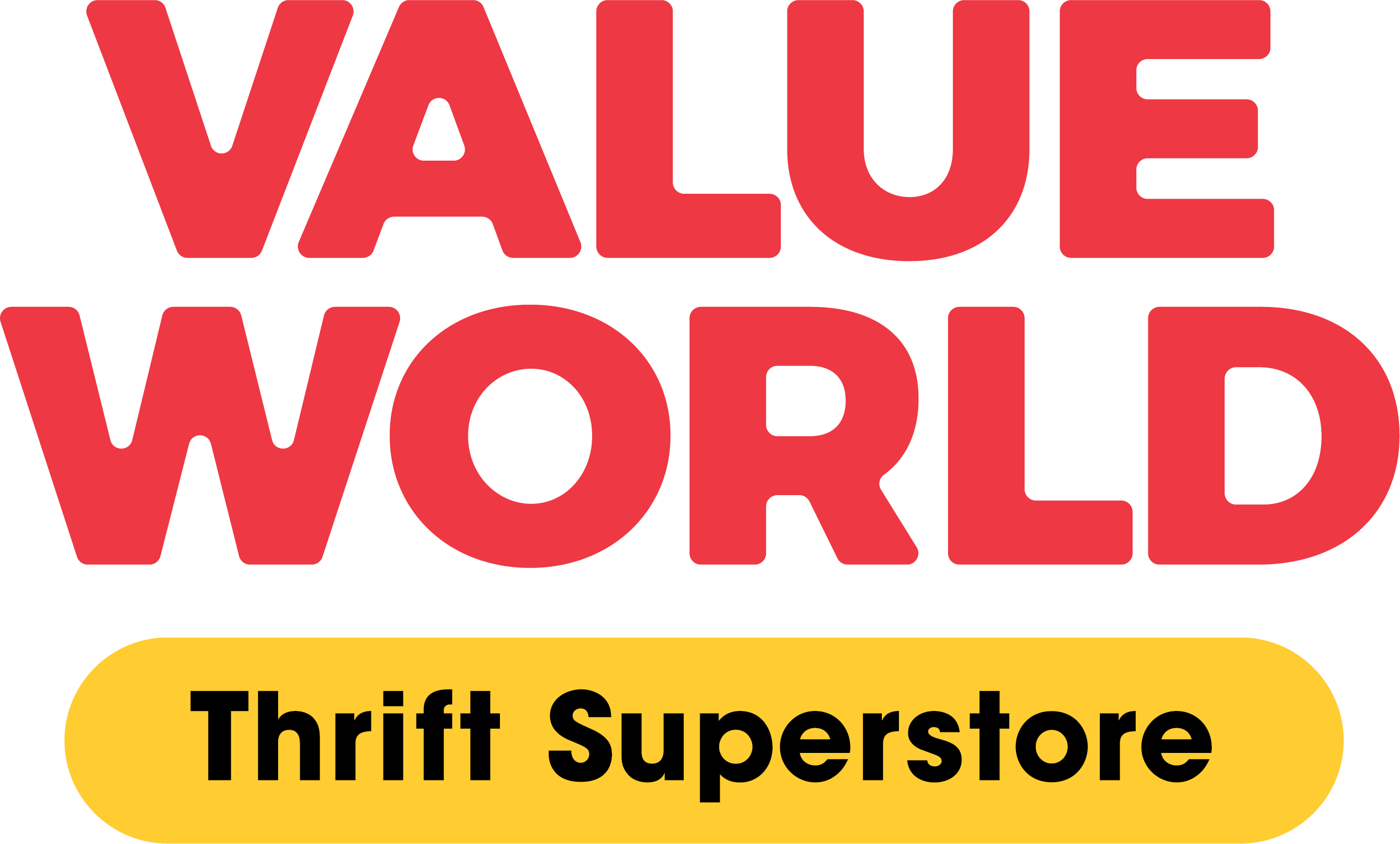The Thrifty Shopper’s Manifesto: Tips for Ethical & Sustainable Thrifting
At Value World, we believe that thrift shopping isn’t just about saving money. It’s a lifestyle rooted in creativity, sustainability, intention, and care for the planet. Whether you’re a seasoned secondhand shopping pro or just starting to explore the racks of your favorite local thrift store, we invite you to join us in shopping with purpose. Welcome to The Thrifty Shopper’s Manifesto, our guide to making smarter, more ethical, and more sustainable fashion choices every time we thrift.
Why Thrifting Matters
Before we dive into the tips, let’s remind ourselves why we choose thrift in the first place. The fast fashion industry has created a culture of overproduction, overconsumption, and excessive clothing waste. But when we shop secondhand, we:
- Extend the life of clothing and goods
- Keep clothes out of landfills
- Reduce demand for new clothing production
- Cut back on carbon emissions and resource use
- Support local jobs and community-driven businesses
In short, we reduce our carbon footprint and still look fabulous doing it. Now let’s talk about how we can shop smarter and better—for ourselves and the world around us.
1. Buy With Intention
It’s easy to get excited when we walk into a thrift shop (hello, five-dollar vintage Levi’s), but the key to sustainable thrifting is intention. That doesn’t mean we can’t have fun or grab spontaneous finds—it just means we ask ourselves a few questions before we head to the checkout:
- Do I really need this item?
- Will I wear or use it more than once?
- Does it fit my style, space, or needs?
- Can I see myself loving it for a long time?
When we shop with intention, we’re less likely to accumulate waste and more likely to find treasures that truly serve a purpose.
2. Don’t Just Buy—Circulate
Thrifting is part of a circular economy, and that only works if we’re also giving items back. Let’s normalize the cycle: buy what we love, care for it, and donate it when it no longer fits our life.
Have clothes that don’t spark joy anymore? A kitchen gadget collecting dust? That garment that just never fit right? Let’s pass them on. Someone else might be thrilled to find what we’re ready to release.
Giving and receiving—that’s how we keep the thrifting magic alive.
3. Look Beyond the Label
Name brands are great, but they’re not the only thing that defines sustainably style or a quality piece. Some of our favorite thrifted clothing finds have been unbranded or lesser-known labels that just work—whether that’s a no-name blazer with the perfect fit or a ceramic mug with charm and character.
We encourage each other to:
- Check materials (natural fibers and raw materials like cotton, wool, and linen tend to last longer)
- Examine stitching and seams
- Feel for thickness, structure, and wear
- Trust our instincts over the tag
When we value quality over brand we become better consumers—focused on environmental sustainability and long-term use.
4. Repair, Reuse, Reimagine
Let’s be honest, not everything we find on the racks is in perfect condition. But instead of passing it by, what if we saw it as a project? That’s a sustainable practice in action.
Maybe that dress just needs a button. Maybe those jeans could become shorts. Maybe that faded T-shirt makes the best lounge wear.
We have the power to bring new life into old items with just a little creativity. Whether we sew, dye, crop, or patch, we’re extending the life of clothes, reducing clothing waste, and making a positive impact.
And if you’re not into DIY, consider supporting local tailors or repair shops. Small fixes can go a long way.
5. Shop for the Long Haul
Trendy pieces are fun, but classics are forever. As ethical shoppers, we aim to build wardrobes and homes that reflect our personal values—not just the latest trend.
That doesn’t mean we can’t experiment, but it does mean looking for thrifted clothing that:
- Is versatile
- Layer well
- Mix and match easily
- Can grow with us as our style evolves
By shopping with longevity in mind, we spend less, waste less, and get more out of every item.
6. Be Mindful of Materials
One of the easiest ways to reduce environmental impact is to pay attention to what things are made of. Natural and biodegradable materials like:
- Cotton
- Linen
- Wool
- Silk
- Hemp
…tend to last longer and break down more safely than synthetic fibers like polyester or acrylic.
That doesn’t mean we never buy synthetics—especially if we’re rescuing them from the landfill, but it helps to know what we’re getting. Fabric content matters when it comes to durability, comfort, and care.
7. Support Local, Support Community
When we shop at a local thrift store, we’re not just saving money—we’re investing in local jobs, small businesses, and community initiatives. Every purchase we make helps keep reuse culture alive, and every visit reminds us that fashion and home goods don’t have to be expensive to be impactful.
We love seeing familiar faces at our stores, chatting with staff, and sharing our favorite finds on social media. Together, we’re building a community of conscious consumers, and it feels good
8. Practice Patience and Play
Unlike traditional retail, secondhand shopping requires a bit of patience. We don’t always find what we’re looking for on the first try. But that’s part of the thrill, isn’t it?
Let’s embrace the hunt. Let’s play with patterns, mix up styles, and let go of perfection. Some days we score big, some days we leave empty-handed, and that’s totally okay.
The more we enjoy the process, the more fulfilling each treasure becomes.
Insider Tips for Thrifting Like a Pro at Value World
Want to make the most of your next Value World visit? Here are a few tips to thrift smarter, not harder.
- Go often.
– Inventory changes daily. A quick 15-minute browse on your lunch break might yield your best find of the year. - Check every section.
– Don’t just stick to your size or gender—sizing can vary, and cool oversized pieces might be in the men’s or plus-size racks. - Bring a list… and an open mind.
– Know what gaps you’re trying to fill in your wardrobe, but stay flexible enough to explore unexpected finds. - Try things on.
– Sizing can be inconsistent, especially with vintage or international labels. Trust the mirror, not the tag. - Sign up for the VIP Club.
– If you’re not part of the Value World VIP Club yet, what are you waiting for? You’ll earn points toward discounts every time you shop and be the first to know about special promotions and double point days.
9. Teach Others the Thrift Life
If we care about sustainability and ethical fashion, let’s bring others along with us. Invite a friend to shop secondhand. Gift a thrifted find. Share your DIY projects or closet wins online.
The more we normalize and celebrate secondhand culture, the more we shift the narrative around consumption. Thrifting isn’t just trendy—it’s a meaningful way to take care of our planet, our pockets, and each other.
10. Remember the Bigger Picture
Thrifting is a powerful choice, but it’s just one piece of the puzzle. When we combine secondhand shopping with other mindful habits, like reducing impulse purchases, repairing what we own, and recycling responsibly, we start to live more consciously overall.
Our individual actions might feel small, but together, they create a ripple effect. And every time we thrift with intention, we’re voting for a different kind of world—one that values sustainability, equity, and creativity over waste and excess.
At Value World, we believe that secondhand doesn’t mean second best. It means smarter. It means greener. And most of all, it means we’re part of something bigger.
So here’s to shopping with purpose, thrifting with pride, and building a better world—one preloved item at a time.
See you in the aisles!
Find your nearest Value World, and start turning fashion on a budget into your everyday look.



